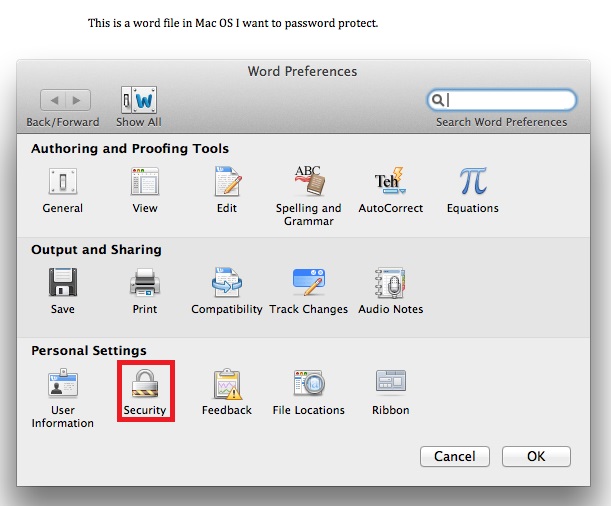
I have created fairly complex registration forms with editable text fields. I went to Word > Preferences> chose to protect Forms and password protected the forms. The text of the questions on the registration form is not editable, but if a user places their cursor NEXT to an editable text box and hits Enter, they are able to add an additional blank row to the form table. Is there a way to lock the form so users are ONLY able to edit the form's text fields and not change the layout or anything else?
I can't reproduce as stated either, and think the user is probably adding a new line into the field. If so, I do not know how to stop that on Mac Word.

There are password-protection features built right in to the Office for Mac 2011 and Office for Mac 2016 suite, which includes Excel, PowerPoint, and Word. All of them have different ways of going about the process for some reason, so I'll breakdown each method.
Microsoft describes a set of macros at to re-assign the Enter key. These macros will work on Mac Word 2011, but unfortunately, they do not also disable the fn-Enter key, and right now I cannot see how to do so. (For others here, I thought it might be possible to combine key 63 with the wdKeyReturn key, but that fails).  Another possibility would be to strip characters such as CR from the string. That would also require a macro, e.g. Sub eliminateExtraLines() Dim s As String s = ActiveDocument.FormFields(Selection.Bookmarks(1).Name.Result ' replace anything that causes spill onto more than one line.
Another possibility would be to strip characters such as CR from the string. That would also require a macro, e.g. Sub eliminateExtraLines() Dim s As String s = ActiveDocument.FormFields(Selection.Bookmarks(1).Name.Result ' replace anything that causes spill onto more than one line.
' there could be other codes. S = Replace(s, vbCr, ') ' resulting from Enter s = Replace(s, vbVerticalTab, ') ' resulting from a hard newline ActiveDocument.FormFields(Selection.Bookmarks(1).Name).Result = s End Sub You would probably nee to put this macro in the template that your forms are generated from. For each form field you need to check, you would edit the field's properties and specify the macro under 'Run macro on Exit' If you cannot use macros, I suspect that the best you can do is set the relevant rows in your table to a fixed height. That does not prevent the user from entering extra lines, but it does prevent the extra text from appearing. I thought it was an extra row created in the table, since the entire document IS a table. It definitely is not the editable text box getting bigger.
The editable text box remains the same size, unchanged and a blank space is created beneath it, full width of the table. For example, the top line of the form (row one) is made in a table that has editable fields for Name, Address, City, State, Zip. When I click immediately to the right or to the left of one of the editable fields, I can hit Enter and a new, blank 'row' is created in the row or space below row one. If I hit Enter again, now there are 2 blank rows beneath Name, Address, City, State, Zip. I hope this might clarify what is happening. I believe it's deceiving because the common interpretation is that a Text Box Form Control is a container similar to a Text Box drawing object.
In reality, it's more like an expandable placeholder which is replaced by the typed content. That's why you get no response from Option+F9 after pressing return -- at that point the control has been replaced by a carriage return. Another point that can be misleading is that the the Form Shading will not extend beyond the one line on which it is inserted unless the content inserted on that line actually wraps to another line. IOW, pressing return to create a paragraph break extends the field but not the shading. Additionally, the display of Fields cannot be toggled On while Protection is in force.
Certainly no injustice has been done:-), but our ability to respond effectively relies on the accuracy of the questioner's description of what's happening. Microsoft word for mac. I understand that the net result may seem the same, but there is a major technical distinction between the height of a row increasing and having a new row appended to the table. Accordingly, the approach to resolution of the issue would differ significantly.
Please mark HELPFUL or ANSWERED as appropriate to keep list as clean as possible ☺ Regards, Bob J.